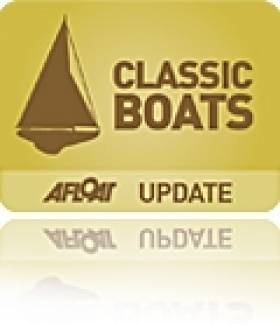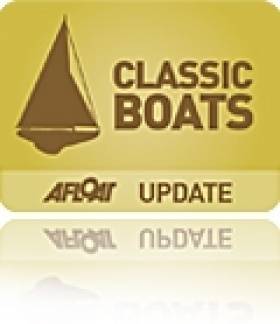Displaying items by tag: Minister Deenihan
#NaomÉanna- Lorna Siggins of The Irish Times writes that Minister Jimmey Deenihan at the Department of Arts, Heritage and Gaeltacht has said that any proposal to save the former Aran island ferry Naomh Éanna will have to include a "concrete business plan".
Mr. Deenihan has put a four-week stay on plans by Waterways Ireland to break up the ferry, and had agreed to meet representatives of the campaign seeking to have the ship saved.
The ferry, which once carried passengers such as James Joyce Ulysses publisher Sylvia Beach and writer Brendan Behan on its regular runs between Galway and the Aran islands, is in dry dock in Dublin's Grand Canal basin, awaiting dismantling.
However, Inland Waterways Association of Ireland ship restorer Sam Field Corbett and a number of public officials believe the vessel as previously reported on Afloat should be saved and refurbished.
As previously reported on Afloat.ie, there are proposals to move the veteran vessel to her old homport of Galway and become a floating maritime museum and form a focal point as part of plans to re-develop the inner harbour.
Naom Éanna Given Months Stay of Execution by Seanad Éireann
#NaomÉanna- The historic heritage ship, Naom Éanna, a former Aran Islands ferry has been granted a month's stay from scrapping, following a decision by Seanad Éireann, writes Jehan Ashmore.
The sudden turn-around of events follows less than a week ago, as previously reported the decision by Minister Deenihan of the Department of Arts & Heritage and the Gaeltacht to reject an appeal by campaigners to save and restore the Liffey Dockyard built vessel from scrapping by Waterways Ireland.
The 438 grt vessel is the oldest surviving example of an Irish ship completed using riveted-hull construction techniques, having been launched in 1958 as yard No. 176. It is also said to be 'one of the last riveted ships built in the world'. The 137 foot was moved last Wednesday from her Grand Canal Basin berth due to safety concerns following hull inspection along Charlotte Quay, home to the vessel for more than a quarter century. She is currently berthed in a nearby 200 year-old graving dock owned by NAMA.
Last week also saw the installation of a new graving dock gate that was hoisted in position by a crane, to allow the facility to pump out water and provide a 'dry' dock for Naom Eanna. In order for campaigners to save her, some €100,000 costs to Waterways Ireland would need to be met, on top of insuring the vessel and permission from NAMA to hold her in dry dock until repairs could begin.
Among those campaigning is the Naomh Éanna Trust which has been calling for the vessels reprieve so to enable efforts to save the ship. Sam Field Corbett of the Irish Ship & Barge Fabrication Co. (IS&BF) has also sought time to implement a business plan to attract private investment for the vessel to be part of a Dublin-based 'maritime quarter'. In addition several T.D.'s lent their support during a debate in Dail Eireann.
The IS&FC has worked on several vessels, notably, the former Cobh based liner-tender, Cill Airne, also built by Liffey Dockyard. Likewise of Naom Eanna, she is a riveted hulled ship completed in 1962 and was restored into service in 2006 as a floating restaurant and bar venue on the Liffey near the Convention Centre.
For three decades the Naom Eanna had operated CIÉ's passenger and livestock three-hour ferry service between Galway City and the Aran Islands.
She appeared in many TV documentaries which depicted the unique way of life of the islanders and the only main form of a lifeline with the mainland, bringing people, cargo and livestock. The latter presented an iconic image as cattle were slung from the ship's hold and lowered into the water to swim ashore while escorted by currach crews to the smaller islands of Inishmaan and Inishsheer, while at Inishmore, the largest island had a pier to disembark livestock.
In 1988 she was withdrawn from Galway Bay service, having failed new safety conditions introduced. She then relocated to Dublin Port's northside Alexandra Basin, where she was laid-up at the lead-in jetty of the old listed graving dock (currently in-filled in recent years) close to former site of the Liffey Dockyard.
The following year the Irish Nautical Trust took her over and she moved southside to the Grand Canal Dock Basin, where she was home to several onboard businesses.

























































